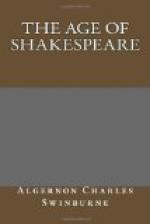In “Edward ii.” the interest rises and the execution improves as visibly and as greatly with the course of the advancing story as they decline in “The Jew of Malta.” The scene of the king’s deposition at Kenilworth is almost as much finer in tragic effect and poetic quality as it is shorter and less elaborate than the corresponding scene in Shakespeare’s “King Richard ii.” The terror of the death scene undoubtedly rises into horror; but this horror is with skilful simplicity of treatment preserved from passing into disgust. In pure poetry, in sublime and splendid imagination, this tragedy is excelled by “Doctor Faustus”; in dramatic power and positive impression of natural effect it is as certainly the masterpiece of Marlowe. It was almost inevitable, in the hands of any poet but Shakespeare, that none of the characters represented should be capable of securing or even exciting any finer sympathy or more serious interest than attends on the mere evolution of successive events or the mere display of emotions (except always in the great scene of the deposition) rather animal than spiritual in their expression of rage or tenderness or suffering. The exact balance of mutual effect, the final note of scenic harmony between ideal conception and realistic execution, is not yet struck with perfect accuracy of touch and security of hand; but on this point also Marlowe has here come nearer by many degrees to Shakespeare than any of his other predecessors have ever come near to Marlowe.
Of “The Massacre at Paris” it is impossible to judge fairly from the garbled fragment of its genuine text, which is all that has come down to us. To Mr. Collier, among numberless other obligations, we owe the discovery of a striking passage excised in the piratical edition which gives us the only version extant of this unlucky play; and which, it must be allowed, contains nothing of quite equal value. This is obviously an occasional and polemical work, and being as it is overcharged with the anti-Catholic passion of the time, has a typical quality which gives it some empirical significance and interest. That anti-papal ardor is indeed the only note of unity in a rough and ragged chronicle which shambles and stumbles onward from the death of Queen Jeanne of Navarre to the murder of the last Valois. It is possible to conjecture what it would be fruitless to affirm, that it gave a hint in the next century to Nathaniel Lee for his far superior and really admirable tragedy on the same subject, issued ninety-seven years after the death of Marlowe.




